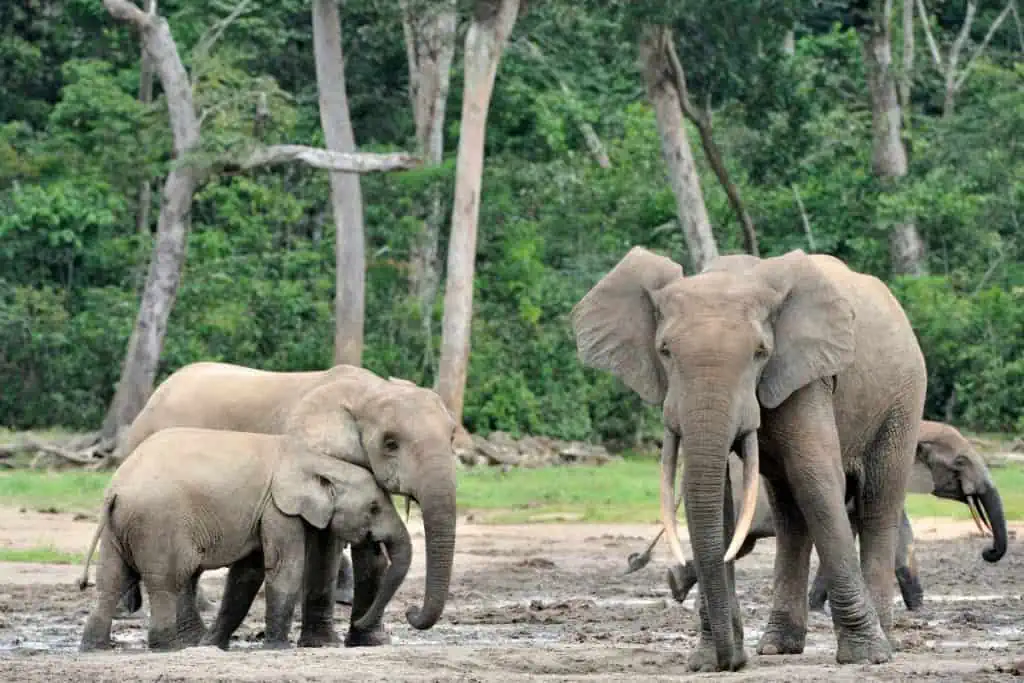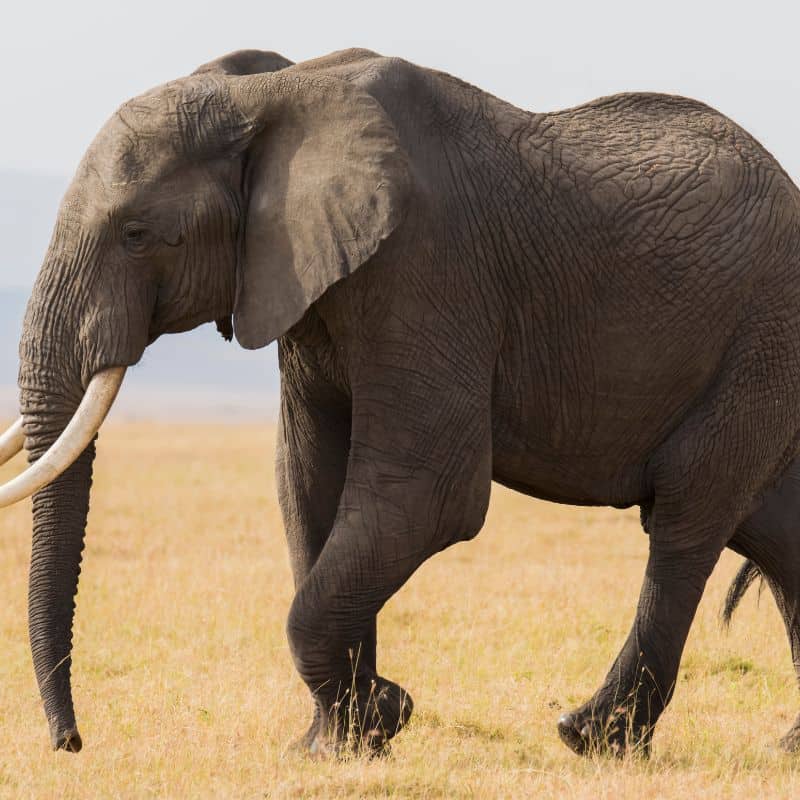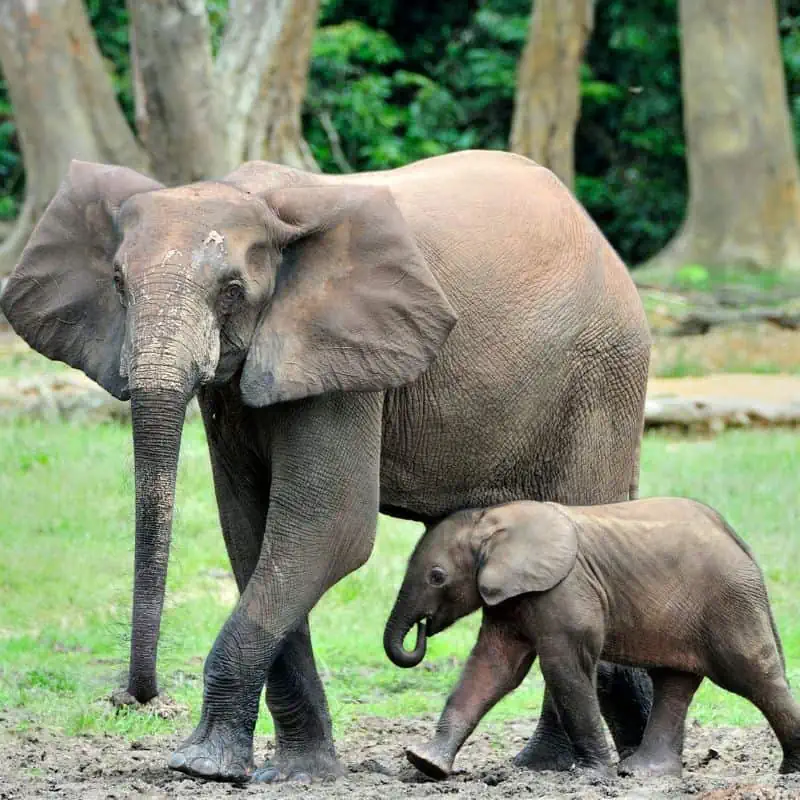Elephants are the largest living mammals on this planet. They establish inter, and intra-species bonds just like humans do. For centuries scientists classified all elephants under one category; however, now it is established that there are currently three distinct elephant species.
The African forest elephant is arguably the most distinct among the elephant species. This marvelous creature stands tall at 3+ meters and weighs over 10 tonnes. The African forest elephant is also the second longest-living land mammal. Unfortunately, this elephant species is also heading toward endangerment.
This article will take you through some interesting facts about the African Forest Elephant.

- 1. They’re Named After Their Habitat
- 2. African Forest Elephants Are the Smaller African Species
- 3. They’re the Second Longest-Living Land Mammal
- 4. The African Forest Elephant Has Distinct Ears
- 5. Their Trunks Are Also Unique
- 6. They Can Be Distinguished by Their Tusks
- 7. Their Family Systems Are Large
- 8. They Have Low Birth Rates
- 9. 24 MPH Is Their Max Running Speed
- 10. They Are a Critically Endangered Species
- Final Thoughts on African Forest Elephants
1. They’re Named After Their Habitat
As their name suggests, the African Forest Elephant is found within the African forests. However, even within these forests, African forest elephants are quite scarce.
The last few strongholds are in the Republic of Congo and Gabon.
You may also find the African Forest elephant in Cameroon, the Central African Republic, and Equatorial Guinea.
These elephants may be seen in Liberia, Ghana, and Côte d’Ivoire in west Africa as well.
2. African Forest Elephants Are the Smaller African Species
Although found in Africa, the African Forest elephant is significantly smaller than the Bush elephant.
With the tallest male elephant measuring up to only 2.5 meters, the African Forest is considered a “mini-elephant.”
They are also much lesser in weight than the enormous Bush elephant. Forest elephants weigh between 0.9-3 tonnes, whereas Bush elephants weigh up to 10-11 tonnes.

3. They’re the Second Longest-Living Land Mammal
The African Forest elephants can live up to 80 years, making them the second longest-living land mammal on the planet.
In comparison, Asian elephants have a life expectancy of 48 years and up, while the African Bush elephant can live up to 70 years.
Humans are the only land mammals that live longer than African Forest elephants.
The other mammals with longer life expectancies live deep under the sea: the Long-finned eels, bowhead whales, Greenland sharks, and ocean quahogs. All of these can live for over a century.
4. The African Forest Elephant Has Distinct Ears
A great way to distinguish the various species of elephants is through the shape of their ears.
Interestingly, African elephants have ears that almost resemble the continent of Africa, whereas the Asian elephant’s ears hold an uncanny resemblance to the shape of the Indian subcontinent.
African forest elephant ears are more oval-shaped and smaller than those of the African Bush elephant.
5. Their Trunks Are Also Unique
The African Forest elephant’s trunk is also distinct from that of the Asian elephant. The former has two “fingers” at the tip of its trunk, whereas the latter only has one.
There are about 150,000 muscle units in an elephant’s trunk. From something as simple as cracking open a peanut with their trunks to lifting an entire reindeer, their trunks can do it all.
Although extremely strong, the elephant’s trunk is also the most sensitive part of the mammal.
Not only do elephants use their trunks for drinking water, but they also use them to navigate and find water sources. An elephant always knows where the nearest water source is.
Fun Fact: The human body has 700 muscles inside it. This means it would take 58 humans to power a single elephant’s trunk.

6. They Can Be Distinguished by Their Tusks
Both male and female African Forest elephants have long, prominent tusks. Their tusks are straight and point downwards.
The shape of their tusks helps distinguish them from the Bush elephants, whose tusks curve outwards. They use their tusks as teeth for eating food.
Moreover, these tusks are also used to dig into the ground, forage, and fight potential predators.
In comparison, only a few male Asian elephants have tusks, whereas none of the female Asian elephants have tusks.
This is mainly because, over the years, elephants evolved without tusks since their tusks made them a target for poachers.
The tusks are made from ivory, a highly desirable material. African Forest elephant tusks have a pinkish tinge, making them even more desirable amongst poachers.
7. Their Family Systems Are Large
The African Forest elephants are social beings and live in family groups of 20 individuals.
Females and males don’t live together in a herd unless the males are young.
Within these family groups, the adult elephants look after their calves together. This is called allomothering. It’s a matriarchal herd, so male elephants aren’t as involved.
The head of the herd is the oldest or largest female elephant.
8. They Have Low Birth Rates
Research suggests that African forest elephants have an extremely slow birth rate, putting them at a higher risk of endangerment.
These elephants start to breed later in life and have significantly longer intervals between their calves.
An average Forest elephant starts breeding around the age of 23 years and normally births a calf every 5-6 years.
Hence, increasing the African Forest Elephant population is a difficult task.

9. 24 MPH Is Their Max Running Speed
African Forest elephants can run at speeds up to 24 miles per hour. Given their enormous size, this is shocking, especially since the Asian elephant can only run up to 15 mph.
They do not move their feet off the ground to achieve these speeds.
Instead, they take more widespread yet fast strides that help distribute their body weight and maintain balance.
10. They Are a Critically Endangered Species
In the last 100 years, there has been a sharp decline in the population of African Forest elephants.
While we can partially attribute this to urbanization, the prime reason for their decline is the illegal poaching and smuggling of elephant ivory.
The IUCN has put the African elephant on its red list of critically endangered species as of 2021.
Currently, just over 40,000 African Forest elephants are left in Africa, which could further decline. Strict measures by WWF etc., have aimed to preserve African Forest elephant populations.
Final Thoughts on African Forest Elephants
The African Forest Elephant is truly a marvelous creature. Like humans, elephants are social beings and establish strong community bonds.
Unfortunately, recent human intervention and poaching have led to a sharp decline in their population.
To conserve this species, strict action must be taken against illegal poaching and other dangerous activities.
